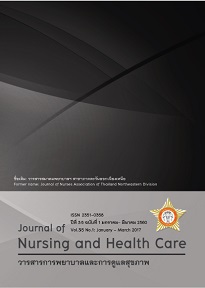การพัฒนารูปแบบการสื่อสารในการส่งต่อผู้ป่วยฉุกเฉินโรงพยาบาลสมเด็จพระยุพราชด่านซ้าย จังหวัดเลย The Development of a Referral Communication Model for Emergency Patients at Dansai Crown Prince Hospital, Loei Province
คำสำคัญ:
การสื่อสารแบบเอสบาร์ การสื่อสารในการส่งต่อ ผู้ป่วยฉุกเฉิน โรงพยาบาลสมเด็จพระยุพราชด่านซ้าย SBAR communication, Referral communication, Emergency patient, Dansai Crown Prince Hospitalบทคัดย่อ
บทคัดย่อ
การวิจัยและพัฒนาครั้งนี้มีวัตถุประสงค์เพื่อ 1) พัฒนารูปแบบการสื่อสารในการส่งต่อผู้ป่วยฉุกเฉินที่มีประสิทธิภาพตามมาตรฐานทางการพยาบาลฉุกเฉิน โรงพยาบาลสมเด็จพระยุพราชด่านซ้าย จังหวัดเลย 2) เปรียบเทียบคุณค่าของรูปแบบการสื่อสารในการส่งต่อผู้ป่วยฉุกเฉินก่อนและหลังการพัฒนา และ 3) เปรียบเทียบประสิทธิภาพของการสื่อสารในการส่งต่อผู้ป่วยฉุกเฉินก่อนและหลังการใช้รูปแบบการสื่อสาร
กลุ่มตัวอย่าง มี 2 กลุ่ม ได้แก่ 1) พยาบาลที่ส่งต่อผู้ป่วยฉุกเฉิน จำนวน 50 คน และ 2) แบบบันทึกการส่งต่อผู้ป่วยฉุกเฉินก่อนและหลังการพัฒนาอย่างละ 44 ฉบับ การวิจัยแบ่งเป็น 3 ระยะ ได้แก่ 1) ระยะก่อนการพัฒนา ศึกษาปัญหาการสื่อสารในการส่งต่อผู้ป่วย และแนวทางการพัฒนารูปแบบ 2)ระยะพัฒนา อบรมการสื่อสารในการส่งต่อผู้ป่วยฉุกเฉินให้แก่พยาบาลและพัฒนารูปแบบ และ 3)ระยะหลังการพัฒนา นำรูปแบบไปใช้ในการสื่อสารในการส่งต่อผู้ป่วยฉุกเฉิน และประเมินผลการใช้รูปแบบหลังการพัฒนา เครื่องมือที่ใช้ ได้แก่ 1) รูปแบบการสื่อสารในการส่งต่อผู้ป่วยฉุกเฉิน 2) แบบสอบถามคุณค่าของรูปแบบการสื่อสารในการส่งต่อผู้ป่วยฉุกเฉิน และ 3) แบบประเมินประสิทธิภาพของการสื่อสารในการส่งต่อผู้ป่วย ความเที่ยงของเครื่องมือชุดที่ 2 และ 3 เท่ากับ 0.88 และ 0.93 ตามลำดับ วิเคราะห์ข้อมูลโดยหาค่าความถี่ ร้อยละ ค่าเฉลี่ย ส่วนเบี่ยงเบนมาตรฐาน และสถิติทดสอบที
ผลการวิจัยพบว่า 1) รูปแบบการสื่อสารในการส่งต่อผู้ป่วยฉุกเฉินที่พัฒนาขึ้นมีแนวทางการสื่อสารแบบเอสบาร์ 3 ขั้นตอน ตั้งแต่การเตรียมการส่งต่อ การดำเนินการส่งต่อ และการสิ้นสุดการส่งต่อร่วมกับการสื่อสารทางโทรศัพท์ และแอพพลิเคชั่นไลน์2) คุณค่าของรูปแบบการสื่อสารในการส่งต่อผู้ป่วยฉุกเฉินหลังการพัฒนาสูงกว่าก่อนการพัฒนาทั้งด้านโครงสร้าง ด้านกระบวนการ และด้านผลลัพธ์อย่างมีนัยสำคัญทางสถิติที่ระดับ 0.05 และ 3) ประสิทธิภาพของการสื่อสารในการส่งต่อผู้ป่วยฉุกเฉินรูปแบบใหม่สูงกว่าก่อนการพัฒนาอย่างมีนัยสำคัญทางสถิติที่ระดับ 0.05และได้นำรูปแบบการสื่อสารในการส่งต่อผู้ป่วยฉุกเฉินไปใช้ปฏิบัติงานในระบบส่งต่อผู้ป่วยของโรงพยาบาลเพื่อการพยาบาลที่มีประสิทธิภาพต่อไป
Abstract
The purposes of this research and development design were: 1) to develop a communication referral model for emergency patients at Dansai Crown Prince Hospital, Loei Province,2) to compare the value of the referral communication model before and after the development, and 3) to examine an efficiency of the referral communication for emergency patients before and after applying the model.
The samples comprised 2 groups: 1) referral nurses for emergency patients and 2) referral charts for emergency patients which were divided into 44 records for before and after developing the model. The research consisted of 3 phases. First, prior to the model development phase-studying problems and guidelines for developing the model.Second, the development phase-training nurses and develop the model. Third, after the model development-implementing the model and evaluating the efficiency of using the model. Research tools comprised 1) the referral communication model for emergency patients, 2) the value of the referral communication model for emergency patient questionnaires, and 3) the efficiency of the referral communication for emergency patient checklist. The reliabilities of the second and the third parts were 0.88 and 0.93 respectively. The data were analyzed by frequency, percentage, mean, standard deviation, and t-test.
The results of this study wear as follows. 1) The new referral communication model included communicating guidelines in SBAR style with 3 steps –referral preparation, patient referral, and referral termination. The communication was done by using telephone and LINE application. 2) The value of the model in terms of structure, process, and outcome subscales was significantly higher than before implementation the model (p< 0.05). Finally, 3) the efficiency of the referral communication was significantly higher than before implementing the model (p< 0.05).And new referral communication model included communicatingsend patients emergency in the referral system.



